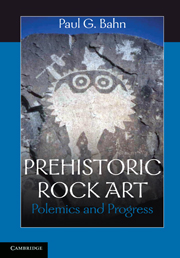Book contents
- Frontmatter
- Contents
- Figures
- Foreword by H. C. Woodhouse
- Acknowledgements
- Introduction
- 1 Art on the rocks
- 2 Myths and meanings
- 3 The emperor's new clothes I: sloppy tailoring
- 4 The emperor's new clothes II: fashion disasters
- 5 Location, location, location
- 6 The votive motive
- 7 Mustn't crumble
- Conclusion
- Select bibliography
- Index
- Frontmatter
- Contents
- Figures
- Foreword by H. C. Woodhouse
- Acknowledgements
- Introduction
- 1 Art on the rocks
- 2 Myths and meanings
- 3 The emperor's new clothes I: sloppy tailoring
- 4 The emperor's new clothes II: fashion disasters
- 5 Location, location, location
- 6 The votive motive
- 7 Mustn't crumble
- Conclusion
- Select bibliography
- Index
Summary
Although rock art probably constitutes the majority of humankind's artistic output, because it spans at least 30,000 years and probably much more, and comprises millions of images, it is generally ignored in art history courses, and even in many archaeology courses, apart from a token mention of Ice Age cave art. Rock art occurs in almost every part of the world, in a wide variety of settings – many of them spectacular. It incorporates a wide range of techniques, from tiny engravings to enormous geoglyphs and from painted dots to huge statues, and it continues to be found every year, even in Britain.
A general history of the discovery of, and research into, prehistoric art has already been given in my earlier volume (Bahn 1998a); but since then a number of myths have been dispelled, new historical data uncovered – and of course many new discoveries of rock art have been made.
Stone horse and papal bull
One of the earliest references to rock art (Bahn 1998a: 3) was found in a claim made by German prehistoric art specialist Herbert Kühn (1895–1980) in one of his last books (1971: 14) that ‘Im Jahre 1458 hat der Papst Calixtus III, einer der Borgia-Päpste, aus Valencia stammend, die kultischen Zeremonien in einer Höhle mit Bildern von Pferden verboten’ (‘In 1458 Calixtus III, one of the Borgia popes, from Valencia, forbade cult ceremonies in a cave with pictures of horses’). Other specialists had also quoted Kühn's claim.
- Type
- Chapter
- Information
- Prehistoric Rock ArtPolemics and Progress, pp. 3 - 31Publisher: Cambridge University PressPrint publication year: 2010



